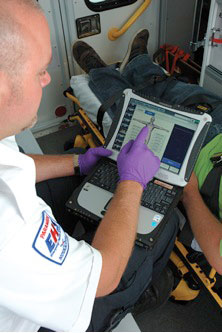Documentation
Published (updated: ).

Every time an EMS unit is dispatched to a call, a Patient Care Report (PCR) must be generated (regardless if the ambulance made it to the scene or did not see a patient). Currently, all PCR’s are inputted into NEMSIS/GEMSIS compliant database, usually completely inputted by EMS personnel after each call with a laptop.
The PCR serves many purposes. The primary purpose of the document is to follow the patient through the continuum of care as a reference document. A PCR is often used to justify a billing report sent to an insurance company. In some cases the PCR is used for legal purposes (in the event the call results in some type of legal action).
Minimally, the PCR maintains a record of the time of each event of the call (EMS unit dispatch, arrival, time patient contact made, and times the patient was transported and arrived at the hospital. A well written PCR must include assessment findings, observations at the scene, and emergency medical care provided (including what was done prior to arrival). Also expected is documentation of any improvements that were seen by the EMS crews and how the call was resolved (disposition). Not every EMS call results in transport, sometimes the patient is turned over to a different unit, sometimes the patient is transported to the hospital, and other times the patient may refuse transport.
| Data Set | Data Type |
| Chief Complaint | Integer (complaints given numbers) |
| Initial Assessment | Text |
| Vital Signs | Integer |
| Patient Demographic | Integer (demographics given numbers) |
| Time Incident Reported | datetime |
| Time Unit Notified | datetime |
| Time of Arrival | datetime |
| Time Unit Left Scene | datetime |
| Time of Arrival at Dest. | datetime |
| Time of Transfer of Care | datetime |
As a legal document, the PCR is extremely useful. Times and objectively measured data seemingly leap out of the report. The report could be used give defendant an alibi or could be the smoking gun for the District Attorney needs to prosecute a DUI as manslaughter. The report will be treated as evidence. The EMS crew will be subpoenaed to the courtroom to explain what the PCR means and is usually asked to try and recall details that weren’t on the PCR (don’t do it, if it wasn’t written down it didn’t happen). When used a legal document, the EMS crew will be presented with a copy of the PCR for reference. It would behoove anyone writing a PCR to be able to understand and explain what was written and why.
Another use for the PCR and all it’s data is for educational purposes. Perhaps the ambulance crew ran an interesting call that could be used to benefit other EMS personnel or even be reported in scientific literature. Research can be conducted by gleaning the data out of PCR’s. Service data can be gleaned from PCR’s, which could help EMS agencies to institute policy changes or try different staffing for the EMS units. The data from PCR’s are typically stored in a relational database which allows supervisory staff to perform quality assurance reports. These reports are generally not looked at favorably by EMS personnel; these are the trade offs of having a job where employees are generally not directly supervised.
